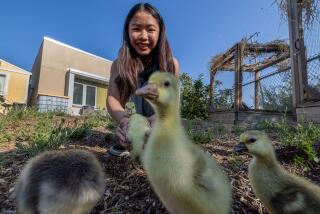Market Watch: In Mar Vista, an aquaponics farm just down the street
Many growers proudly advertise their local origins, but when David Rosenstein of Evo Farm sells his produce on Sunday for the first time at the Mar Vista farmers market, he says he will be talking “not about food miles, but food feet.”
Rosenstein has built an innovative prototype aquaponics farm, combining aquaculture and hydroponic (soilless) vegetable cultivation, in a neighbor’s backyard. Each of these systems by itself generates copious waste, but when they are synergized, the fish provide the fertilizer for the plants and the plants filter the water for the fish.
Ancient Mesoamericans practiced a primitive form of aquaponics, cultivating plants on rafts on lakes. Modern aquaponics systems were developed in recent decades by several researchers, including James Rakocy at the University of the Virgin Islands. There are now many aquaponics enthusiasts on a small scale (“barrellponics”), but Rosenstein may be the only one practicing it commercially in Southern California, he says.
Rosenstein, who at 37 has a boyish appearance and earnest manner, combines intense idealism with a practical, can-do approach. He grew up in the San Fernando Valley and on the Westside, the son of a electronics manufacturer, and graduated from UC Santa Cruz with a degree in sociology. The next summer he drove a tomato truck in the San Joaquin Valley, where he acquired a distaste for industrial agriculture. He spent much of his 20s working as a geotechnical engineer and indulging his passion: rock climbing. More recently, he helped produce environmentally conscious programs for public television and became inspired to make a difference himself.
“I decided that food is the common thread that can solve the world’s problems, such as climate change, peak oil, chronic disease, even economic contraction,” he says. “To be part of the change, I wanted to be actively involved in bringing food closer to people.”
Two years ago, he and his wife, Cecile Lopes, took a class in aquaponics and decided to establish an experimental farm near their home in Mar Vista. He posted an ad on Craigslist, looking for homeowners who would let him build a greenhouse on their property, and he received numerous responses from all over the city. But his wife, who works in corporate finance, was pregnant with their first child, and “the last thing I wanted to do was spend two hours commuting every day,” he says. So he searched on Google Earth for nearby oversized but underutilized properties, slipped fliers in mailboxes and found a neighbor who agreed to let him build a structure in return for all the vegetables that his family could eat.
Rosenstein came up with a one-of-a-kind design for a 500-square-foot greenhouse that produces lots of food in a small space, is highly water-efficient and operates completely off the utility grid. Over the winter of 2010-11, he and a friend built the structure, with three fish tanks and racks of vegetables, stacked to take advantage of the varying temperatures from top to bottom.
As he worked to adapt the aquaponics system to the local water chemistry and climate, Rosenstein found out the hard way what not to do. In warmer areas such as Hawaii and southern Florida, for instance, tilapia is the fish of choice for aquaponics systems, but even the moderate Los Angeles winter proved too chilly for the heat-loving fish. After a cold snap last December, the water temperature sank into the death zone, and the fish ended up in the compost pile.
“Tilapia just don’t make sense here, because you need to heat the water,” says Rosenstein. “You’re fighting nature.”
He restocked his three 250-gallon tanks with several species of catfish. When he tosses pellets of feed into the tanks, it looks like the tanks are boiling, as hungry fish roil the water. Little do they know that the more they eat, the more quickly they will outgrow the system and end up in a fish fry. Currently, however, Rosenstein is not looking to sell the fish, because the revenue would not justify the expense of a commercial aquaculture license, which would be required, he says.
His main focus is in growing vegetables, including 50 kinds of lettuce, Asian greens, basil and tomatoes. He has 1,000 plants growing for harvest and 9,000 seedlings in his nursery, where they are tended several hours daily by the nursery manager, Yuni Lee, an artist who lives nearby. Until recently, Rosenstein had been giving away the produce to friends while experimenting to find varieties that produce well and taste good.
Now, however, he is excited at the prospect of selling his harvest for the first time on Sunday at the Mar Vista market, five blocks from the farm. He will bring living plants with their roots still attached so that if they don’t sell they can be replanted in his system. Currently he doesn’t have enough to sell every week, but he will return when production allows.
Unlike some farmers market vendors who carefully guard their secrets, Rosenstein is eager to teach others. Last weekend he hosted several hundred visitors on a tour of his growing facility, and he’ll be giving a class on the Art and Science of Aquaponics on May 26-27.
He has had discussions with local homeowners interested in hosting his next venture, a much larger commercial farm that he plans to build this year in the area. He hopes this will allow him to fulfill his dream: that he and Cecile could support their family doing work they love.
“I’m in this for social, environmental and health reasons, but to be a sustainable venture, it has to be financially viable,” he says. “It’s time to turn the corner from being a hobbyist to being a real farmer.”
More to Read
Eat your way across L.A.
Get our weekly Tasting Notes newsletter for reviews, news and more.
You may occasionally receive promotional content from the Los Angeles Times.






